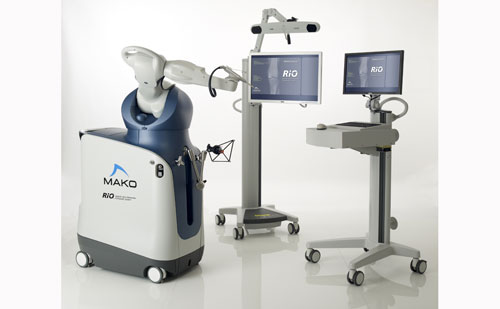An orthopedic surgeon explains what it will take to get widespread physician adoption of advanced technologies such as computer-assisted surgical navigation and surgical robots.
September 16, 2015

An orthopedic surgeon explains what it will take to get widespread physician adoption of advanced technologies such as computer-assisted surgical navigation and surgical robots.
Jamie Hartford
Companies like Stryker have struggled to sell surgeons on new technologies, such as its RIO surgical robotic system, shown above. |
Imagine if you could purchase a software program to make your job easier or, better yet, buy a robot to do your job for you. Sounds like a no-brainer, right?
But orthopedic surgeons haven’t been so easily convinced to embrace technologies such as computer-assisted surgical navigation software and surgical robots. Case in point: Stryker’s struggle to gain traction with its MAKO surgical robotics systems.
Part of the problem for robots, of course, is the fact that they’re expensive, says Neil Sheth, assistant professor of orthopedic surgery at the University of Pennsylvania.
“If the robot costs $1 million, and most guys are doing 20 [surgeries] a year, their hospital isn’t going to buy it for them,” Sheth says. “ And the guys who are doing 600 [surgeries] a year don’t need the robot because this is all they do every day.”
But technological advances also get a bad rap among orthopedic surgeons.
“The concern, in general, with a lot of this technology is that it’s trying to make bad surgeons into good surgeons,” Sheth explains.
It’s a problem not unlike that seen in the aviation industry in the 1970s, when pilots shunned the newly introduced “autopilot” feature in airplanes, he adds. Today, you’d be hard-pressed to find a pilot who doesn’t occasionally hand the controls over to “George,” as autopilot is jokingly referred to by aviators.
So how can medtech companies get orthopedic surgeons to the same place with technologies like computer-assisted navigation and surgical robots? Sheth has a theory: Start them young.
“I think one of the ways to really introduce technology is through education,” he says.
Sheth, a specialist who performs about 450 joint replacement surgeries per year and has a patient-satisfaction rate of 80% to 85%, says using a computer navigation system would likely only add time to his own procedures.
“However, as a teaching tool I think it would be great,” he says. “It’s a tool that we could use to help teach med students and fellows to understand their tendencies are and change them before they become problematic.”
Sheth, who will speak on a panel about what physicians want and need in medical devices at the MD&M Philadelphia conference on October 7, 2015, says it behooves companies with ahead-of-the-curve technology to get their devices into teaching hospitals.
“That way, you’re training the next generation of people coming out of medical school, and they may have that in their contracts that if you want me to do knee replacements at your hospital, I need this system.”
Jamie Hartford is MD+DI’s editor-in-chief. Reach her at [email protected] or on Twitter @MedTechJamie.
[image courtesy of STRYKER]
You May Also Like


